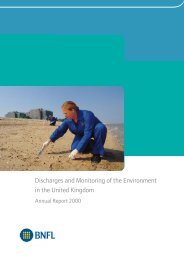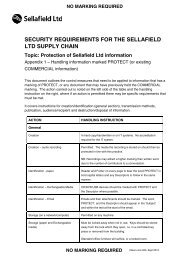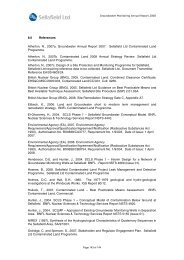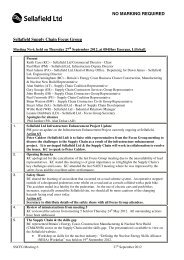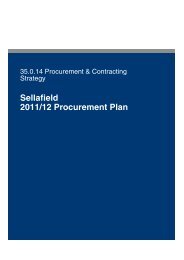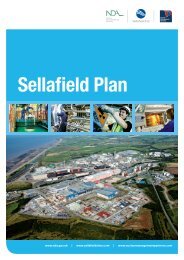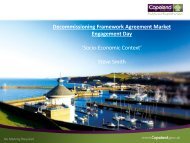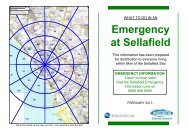Annual Report for 2010/11 and Forward Programme - Sellafield Ltd
Annual Report for 2010/11 and Forward Programme - Sellafield Ltd
Annual Report for 2010/11 and Forward Programme - Sellafield Ltd
Create successful ePaper yourself
Turn your PDF publications into a flip-book with our unique Google optimized e-Paper software.
SSEM/20<strong>11</strong>/4730 June 20<strong>11</strong>Table 3.9. Basic statistics data in 3.8 converted from the natural log values back to activities.Radionuclide =>241 Am Activity(Bq)239 Pu Activity(Bq)238 Pu Activity(Bq)Mean 2.55E+04 1.58E+04 1.53E+04Q1 1.56E+04 8.73E+03 9.59E+03Median 2.52E+04 1.57E+04 1.52E+04Q3 4.08E+04 2.66E+04 2.31E+04Minimum 2.20E+03 2.68E+03 5.01E+03Maximum 6.34E+05 3.09E+05 8.81E+04One particle has been found on Drigg beach with a combination of processed actinidematerial (i.e. 4.48E+03 Bq of 241 Am) <strong>and</strong> activation products (i.e. 8.65E+03 Bq of 60 Co). Thisfind was recovered in October 2007 <strong>and</strong> no further finds of this type have been recoveredsince this date. There are no site processes that combine these two radionuclides so this findwas probably <strong>for</strong>med within the effluent system from a combination of waste streams.Six alpha-rich stones have been found on the <strong>Sellafield</strong> beach with processed actinideactivity (i.e. 241 Am); two of which also had fission product activity (i.e. mainly 137 Cs but onewith a small amount of 154 Eu). The most probable source of these finds is the absorption ofactivity from the authorised discharges from the <strong>Sellafield</strong> pipeline. The stones may havebeen in close proximity to a hole in the pipeline over an extended period of time <strong>and</strong> thenreleased during the pipeline removal project(s).A beta-rich find sub-group assessment report is currently in draft awaiting further data fromSerco. Up to the 31/03/20<strong>11</strong> 428 beta-rich finds have been categorised as stones <strong>and</strong> 270 asparticles, with 27 of these particles also categorised as excess beta-rich. The radionuclideactivity is almost completely attributed to 137 Cs with low levels of other radionuclides presentin a small number of finds. As the data is more limited than that available <strong>for</strong> alpha-rich findsit was not possible to use the approach taken <strong>for</strong> the source identification of alpha-rich finds<strong>for</strong> the beta rich finds. The age of a mixed fission product source can be estimated if both134 Cs <strong>and</strong> 137 Cs isotopes are present <strong>and</strong> the fuel source is known. In this case, the 134 Csactivity estimates are almost all at the limit of detection <strong>and</strong> the fuel source is not known. Thebest age estimate that can be achieved is there<strong>for</strong>e based on a default Magnox referencefuel type <strong>and</strong> LOD 134 Cs results, which gives a find age of greater than 16 years old. As thisage is greater than 16 years it can not be directly compared with the 35 years estimated <strong>for</strong>alpha-rich finds. The limiting factor in the age calculation comes from the short 134 Cs half lifeof just 2 years compared to the 30 year half life <strong>for</strong> 137 Cs. Table 3.10 shows how quickly the134 Cs half life becomes critical with the Caesium isotope ratio becomes very large after 15years.© Nuclear Decommissioning Authority 20<strong>11</strong>. 48



